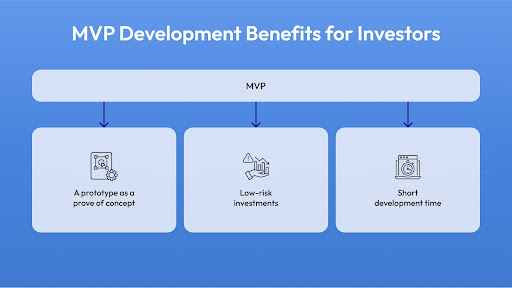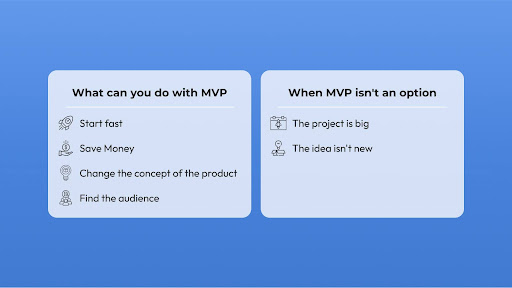Finding a balance between innovation and consumer happiness is essential for successful product development. Making sure your product fulfills a real demand is crucial in the cutthroat market of today.
This article will examine the advantages and possible disadvantages of the Minimum Viable Product (MVP), which is an essential element of a startup’s success. After reading this post, you will know how to use MVP to grow your company to new heights.
What is the MVP?
A Minimum Viable Product (a.k.a. MVP) is a basic notion that is essential for validating and refining new app concepts. It includes the essential functionality needed to address a particular client issue, allowing developers to get insightful user input.
Evaluating a company idea’s potential in the actual market is the main goal of creating an MVP. Developers may start a simple product iteration and learn about consumer responses and preferences. Making educated judgements on upcoming development initiatives is possible with the help of this knowledge. Positive reviews and active users indicate that there may be room for more funding to improve and grow the app. On the other hand, indifferent answers might suggest that a revision or reevaluation is necessary.
Building MVP allows developers to focus on essential functions that meet customer needs, helping startups allocate resources efficiently and minimize risk. This method encourages rapid testing and improvement, increasing the likelihood of creating a product that succeeds and appeals to consumers.
Therefore, MVP is essential for reducing risk and effectively allocating resources. Developers may adapt quickly to the changing demands of their audience and provide value-driven solutions by prioritizing critical features and using a lean methodology. Launching an MVP that targets a particular consumer issue and obtaining insightful user feedback are crucial.
From Minimum Viable Product to Maximum Investor Interest
The MVP methodology allows startups to test their business ideas with minimal investment, assess feasibility, and improve strategies before product development. This provides investors with confidence in the startup’s potential growth and market readiness.

Businesses that show a thorough grasp of their target market and a readiness to make adjustments in response to criticism tend to draw in investors. Startups may get important information about user behavior and preferences by using an MVP that was produced more quickly than the same product with advanced capabilities. This information helps the startups make well-informed choices regarding product development and marketing tactics. This data-driven strategy demonstrates to investors the startup’s dedication to providing value to its clients while also raising the probability of product success.
Additionally, by using the MVP model, entrepreneurs may save time and money by not wasting them on building products that might not appeal to their target market. Startups may verify their concepts and make required improvements before devoting a substantial amount of time and resources to full-scale production by conducting early testing of a basic version of their product. Investors that want to wait to commit capital until they can see proof of market demand may find this risk reduction technique intriguing.
MVPs not only lower investment risks but also increase interest from possible investors. Startups that have successfully developed and tested an MVP are more likely to secure funding as they have demonstrated their ability to execute on their ideas and pivot when necessary. Startups that have potential and a desire to grow from their setbacks are more likely to get backing from investors.
Considering everything, entrepreneurs aiming to maximize investor interest will greatly benefit from understanding the difference between a business plan and a business proposal. By using MVPs, startups may lower risks, promote valuable data collecting, encourage innovation, and develop trust.
This tactic not only helps investors by reducing perceived risk but also sets up businesses for long-term success in a cutthroat market. MVP adoption will probably become the norm for luring investors and propelling expansion in the startup ecosystem, given that businesses continue to embrace lean methodologies and give priority to customer feedback. Businesses that emphasize MVP development have a better chance of securing capital, forming alliances, and ultimately growing to a profitable size.
How MVPs Help You Turn Your Vision into a Product
The simplicity and utility of MVPs captures user attention more effectively than. Consider the success of Uber, Twitter, Periscope, and Instagram – all started as humble MVPs with unique features and minimalist interfaces. As you use these platforms, more features were added with ease, and the result became the widespread phenomenon it is today.
The real appeal of MVPs is in presenting you and your clients with new ideas that may be gradually adapted to and eventually loved. MVPs facilitate instant engagement by giving priority to user-friendly interfaces over unnecessary functionality, hence easing the strain of a steep learning curve. Simplicity is not just a preference but a necessity – and MVPs excel in delivering precisely that.
MVPs facilitate communication between developers and your business, creating a supportive atmosphere for input and teamwork. Users like yourself are important contributors to the development process, providing insightful comments and ideas that help shape the final product. In addition to increasing customer happiness, this cooperative effort ensures that the finished product meets the demands of the target market.
Why MVP Is a Game-Changer for Developers
By streamlining the project scope, MVP development frees up engineers to concentrate on key features. It helps developers to thoroughly outline the architecture of the product, deal with integration and scalability difficulties early on, and provide a solid basis for next versions.
The development team’s culture of continuous improvement is fostered and creativity is encouraged by the iterative nature of MVP development. The advantages of MVP become more apparent to developers as they progress, since its simplified design reduces the likelihood of problems and system failures. Reduced testing durations result in quicker feedback loops and deployment cycles, which allow developers to more effectively spend resources to improve functionality and user experience.

The Pros and Cons of MVPs: A Comprehensive Guide for Entrepreneurs
Let’s uncover the assets that an MVP brings to the table:
Starting Fast. With an MVP, you have the distinct advantage of launching your product swiftly, safeguarding your ideas from potential theft or obsolescence. By condensing the development timeline to as little as one to five months, you seize the opportunity to stake your claim in the market ahead of competitors.
Every Penny Counts. In the realm of business, fiscal prudence is paramount. An MVP not only streamlines development costs by minimizing functionality but also reduces expenditure on bug fixing and system crashes. By focusing resources on essential features, you maximize the return on investment and ensure optimal allocation of financial resources.
Change the Concept. Flexibility is a hallmark of MVP development. The ability to pivot and adapt your product concept based on user feedback is a distinct advantage. Take the example of Instagram, which transitioned from a GPS-based application to a photo-sharing platform. By remaining agile and responsive to market demands, you position your business for sustained success.
Find the People. Understanding your target audience is important for business growth. With an MVP, you can gather insights into user preferences and behaviors. Analyzing user engagement and feedback allows you to customize your business product to meet the specific needs of your audience, leading to increased loyalty and engagement.
While the assets of an MVP are palpable, there are instances where this approach may not be suitable:
A Big Project. For large-scale initiatives involving complex systems or organizational processes, an MVP may not suffice. In such cases, comprehensive planning and meticulous execution are imperative to ensure the seamless integration of diverse functionalities. The Idea Isn’t New.
Innovation is the cornerstone of MVP success. If your product concept lacks novelty or fails to distinguish itself from existing solutions, pursuing an MVP may yield limited returns. It is essential to refine and crystallize your unique value proposition before embarking on the development journey.
Conclusion
Adopting an MVP approach is a commitment to lean, agile, and customer-centric practices and is more than simply a technique. But it’s important to understand that MVP isn’t a universally applicable strategy. To find out what the case is for your particular business scenario, you may apply to a knowledgeable software development company.
The experts at the vendor will assist in assessing your unique requirements, honing your product concept, and guiding you through the iterative MVP development process to make sure your finished product successfully satisfies your clients’ expectations as well as your company goals.
Author’s bio: Yuliya Melnik is a technical writer at Cleveroad, a company specializing in MVP development services, located in Ukraine. She is passionate about innovative technologies that make the world a better place and loves creating content that evokes vivid emotions.


